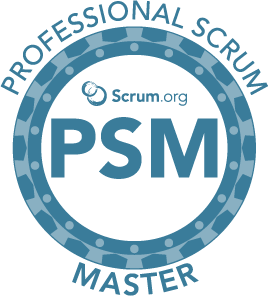
The Professional Scrum Master I (PSM I) course teaches techniques your team can use to enact Scrum well.
This course covers Scrum basics, including the framework, mechanics, and roles of Scrum. But it also teaches how to use Scrum to optimize value and productivity.
Students learn through instruction and team-based exercises. The learn to think on their feet. This enables them to better understand what to do when they return to their workplaces.
[ESPRESSO_EVENTS_TABLE_TEMPLATE category_slug=PSM order_by=start_date limit=12 table_paging=false table_search=false category_filter=false]Ken Schwaber initially designed the PSM course in 2009 as a significant update of the Certified Scrum Master (CSM) course that he created in 2002.
Ken Schwaber write the original PSM course in 2009. Scrum.org has maintained and enhanced it since with contributions from Ken and other experts in the Scrum.org network of Professional Scrum Trainers. Scrum.org maintains the defined curriculum and materials for the Professional Scrum Master course and selects only the most qualified instructors to deliver this course.
Each instructor brings his or her individual experiences and areas of expertise to bear, but all students learn the same core course content. This improves their ability to pass the Professional Scrum Master assessments and apply Scrum in their workplaces.
Audience
Scrum Masters are the target for the Professional Scrum Master course. However, the lessons are applicable to anyone in a role that supports developers’ efficiency, effectiveness, and continual improvement. This course aids those responsible for the successful use and/or rollout of Scrum in a project or enterprise.
PSM Syllabus
This two-day course covers the following:
- Scrum Basics. What is Scrum and how has it evolved?
- Scrum Theory. Why does Scrum work and what are its core principles? How are the Scrum principles different from those of more traditional software development approaches, and what is the impact?
- Scrum Framework and Meetings. Learn how to implement Scrum theory using time-boxes, accountabilities, rules, and artifacts.
- Scrum and Change. Scrum is different: what does this mean to my project and my organization? Adopting Scrum requires significant change in my organization. How do I make that happen?
- Scrum and Total Cost of Ownership. How do we measure and optimize the Total Cost of Ownership (TCO) of our systems or products?
- Scrum Teams. Scrum Teams are self-organizing and cross-functional; this is different from traditional development groups. How do we start with Scrum teams and how do we ensure their success?
- Scrum Planning. Plan a project and estimate its cost and completion date.
- Predictability, Risk Management, and Reporting. Scrum is empirical. How can we make predictions, control risk, and track progress using Scrum? Discussion starts with “Done and Undone” and continues with Quality Assurance in Scrum.
- Scaling Scrum. Scrum works great with one team. It also works better than anything else for projects or product releases that involve hundreds or thousands of globally dispersed team members. How is scaling best accomplished using Scrum?
PSM Assessment and Certification
Unlike other Scrum certifications that require only class attendance, Scrum.org certification requires a minimum score on a rigorous assessment.
While these assessments are available to the public for purchase, if you complete the Professional Scrum Master course you will receive a password to take the PSM I assessment one time. If you fail the assessment within 14-days, you will receive one more attempt for free.
Once you pass the PSM I assessment you will receive your PSM I certificate and your name will be appear on the Professional Scrum Master I certification list.